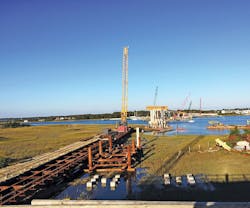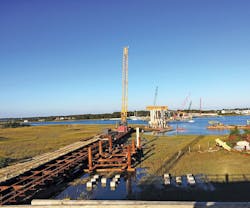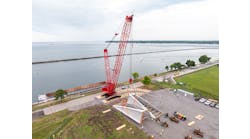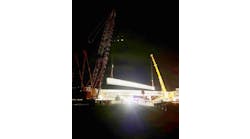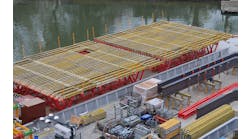By: Bill Wilson
This did not answer to Matthew or Hermie or Joaquin. Hurricanes have a way of doing their own thing regardless of how many times you plead with them or curse them out.
The best way is to just deal, and prime contractor Conti Enterprises Inc. learned quickly how to prep for Hurricane Joaquin, the first of three one-eyed storms that ripped through North Carolina in 2015. Hurricanes Hermie and Matthew followed the next year, and the weather family also included tropical storms Ana (2015), Julia, Colin and Bonnie (all in 2016). Conti learned to brace for all of them during the construction of the U.S. 70 Gallants Channel Radio Island Bridge, which earned a No. 1 ranking in the 2017 Roads & Bridges Top 10 Bridges list.
“The winter of 2015-16 was the worst,” Mike Prudente of Conti Enterprises Inc., told Roads & Bridges. “That is when we were setting a lot of girders. We would have to work around the weather.
“If we had excessive winds coming that day we would cancel the girder setting.”
Conti came up with a detailed and thorough Hurricane Protection Plan prior to beginning work on the project, which marked the first time the contractor broke ground in the state of North Carolina. Hurricanes would be tracked for days, and checklists would be executed.
“Two or three days before, if it looked like the path was potentially going to impact the project area, we would start battening down the hatches, start clearing all of the debris, stack all of the loose items and clearing everything off the top of the bridge,” said Prudente.
On a couple of occasions, including during Hurricane Matthew, Conti moved cranes and barges to safer waters at the Morehead City Port. It was a two-day prep and a two-day recovery process every time a major storm hit.
Another natural element crews had to work with were the natural tides of the Atlantic Ocean. The highest tide gave Conti about three to four hours to work. The window came into play when girders were being set off barges. The concrete bulb T girders were precast in Savannah, Ga., and were delivered via the intercoastal waterway to the project. About 21 barge loads were needed to carry 270 girders for the 3,395-ft-long bridge. Two cranes, a ringer crane and a Manitowoc 4100 executed tandem picks of the girders off barges. A 1,400-ft-long temporary trestle also was constructed for a portion of the bridge erection that occurred in a wetland area. There, a 300-ton Liebherr crane handled the girders. Two types of girders were employed: 54-in. precast, pre-stressed bulb T (78-94 ft long and 35 tons) and 78-in. precast, pre-stressed bulb T (118-164 ft long and 74-117 tons). The Turner Street Bridge, which also is part of the project and will be 585 ft long when complete, has a total of 72 45-in. precast bulb T girders that weigh 18 tons each.
The pile driving required for this job also was a major test for Conti. In the main channel a crane was placed on the temporary trestle to help put the pre-stressed concrete piles, which were a combination of 30 in. by 30 in., which weighed over 100,000 lb and were as long as 114 ft, and 20 in. by 20 in. into position for the Gallants Bridge. The Turner Street Bridge had 16-in. by 16-in. and 20-in. by 20-in. pre-stressed concrete piles that were 44-66 ft long. All of the piles were delivered by barge to the location. A template was installed to assist with the pile driving. Temporary steel casing was vibrated in, and a steel frame was constructed. The steel frame had rollers on it, and crews would essentially slide the piles down. Some of the piles were so long, a two-tiered template was needed. The piles were placed 60 ft deep. The end bents for the Gallants and Turner bridges had 11 piles. The pile cap bents for the Gallants had eight to 13 piles while the large pile cap with columns and caps required 14 to 30 piles. The caps for the Turner Street Bridge had 12 piles.
“The logistics of just getting the piles to the equipment was cumbersome,” said Prudente. “And because it was tidal, part of the day we were in the dry and the other part of the day we were in the wet.” To help deal with the tides the templates were floating instead of fixed, so they moved with the current to allow the work to happen at any time during the day.
All the piers for both bridges were cast in place. Precast panels were set on top of the piers to form the superstructure and then the deck was cast in place. Crews slipformed the parapets.
Since the Gallants Channel Bridge was built over salt water it required immense amounts of various types of concrete, which contained a corrosion inhibitor. Over 2,100 cu yd of lightweight concrete was used on the main span of the Gallants Bridge. To transport the concrete from land to barge for pouring segments of the structure, Conti constantly rotated four carpenter barges so concrete production would not slow down. To handle the equipment and material deliveries from the barge, cranes were used with 150- to 250-ft booms to reach the barges in the water.
The Gallants Bridge is replacing a structurally deficient bascule bridge, and at press time it was about to open to traffic. The Turner Street Bridge was a little bit further behind and was scheduled to open soon. Despite the hurricanes and tropical storms, the Gallants Bridge will still open on time according to the North Carolina DOT schedule.
“They had mechanical and electrical issues [with the existing bridge] for a while,” said Prudente. The new Gallants Bridge is a fixed span that is 65 ft high to the girders. “It would get stuck in the open position every so often.”
Project: U.S. 70 Gallants Channel Road Island Bridge
Location: Carteret County, N.C.
Owner: North Carolina DOT
Designers: North Carolina DOT, Michael Baker International
Contractors: Conti Enterprises Inc., Orion Marine, Intercoastal Marine
Cost: $66.5 million
Length: Bridge 1: 3,395 ft; Bridge 2: 585 ft
Completion Date: December 2017
About The Author: Wilson is editorial director of Roads & Bridges.
